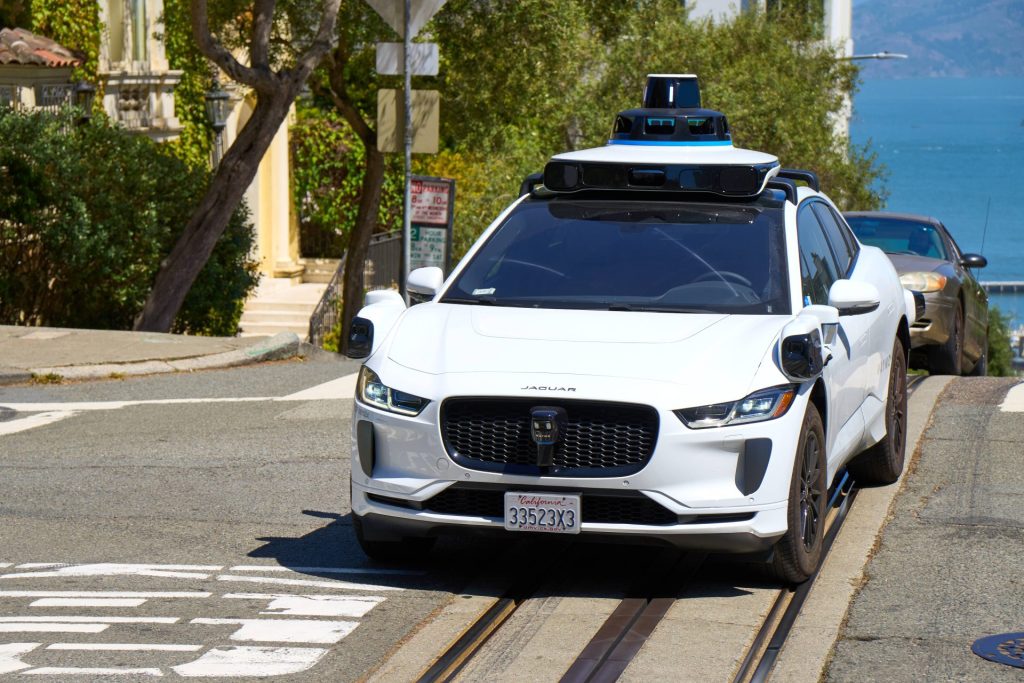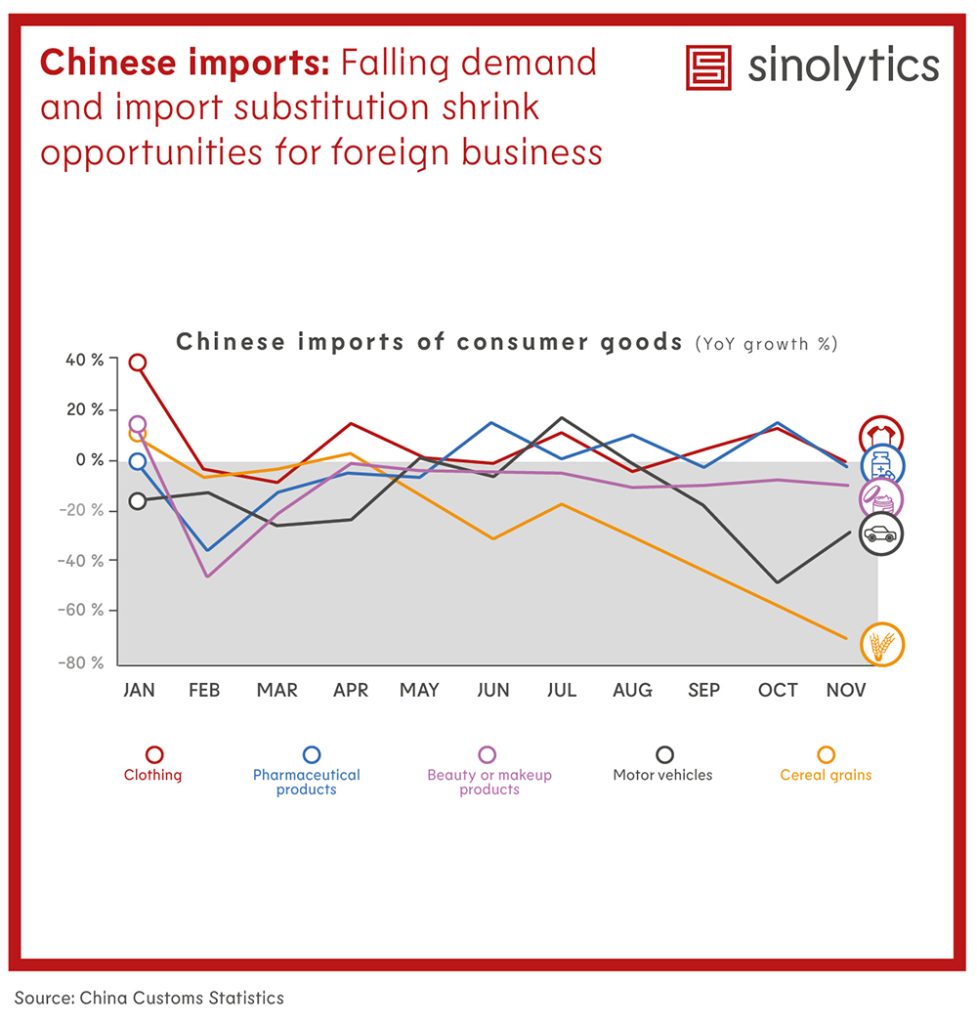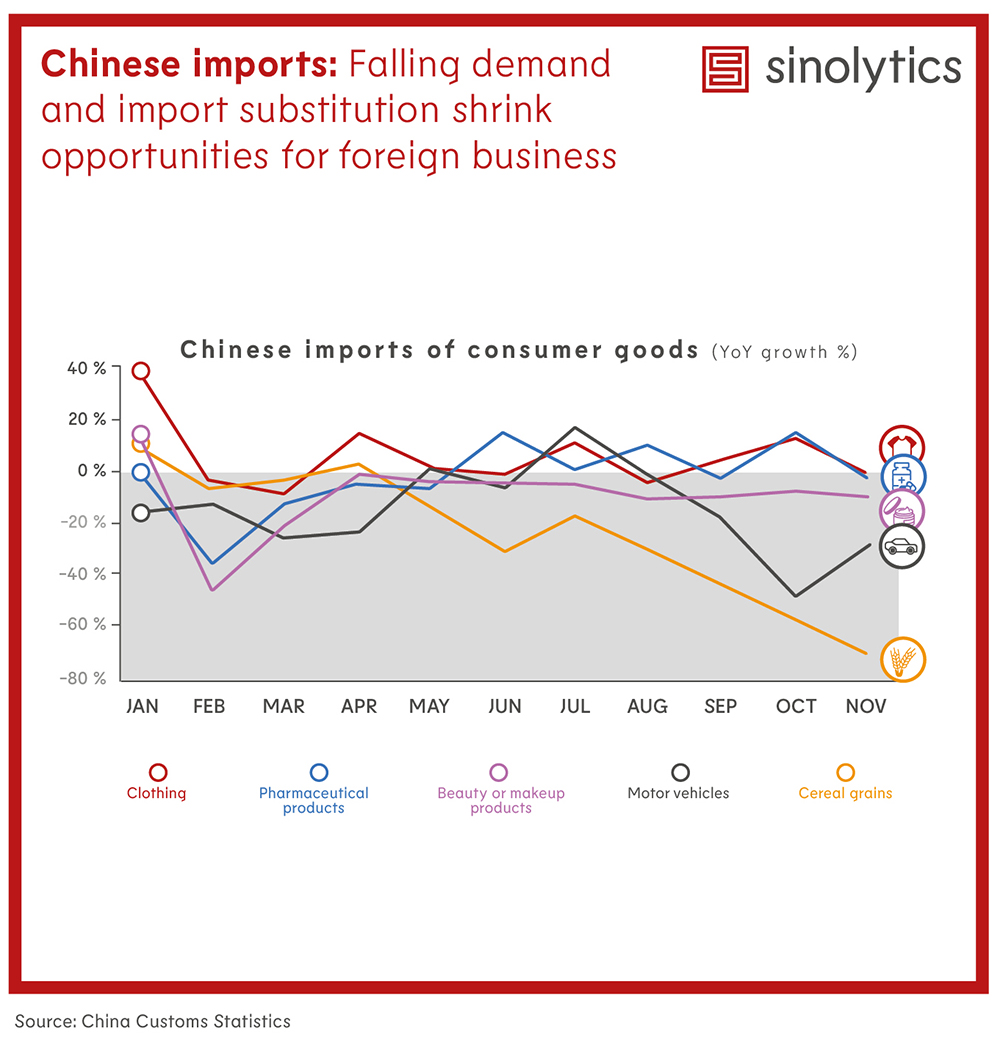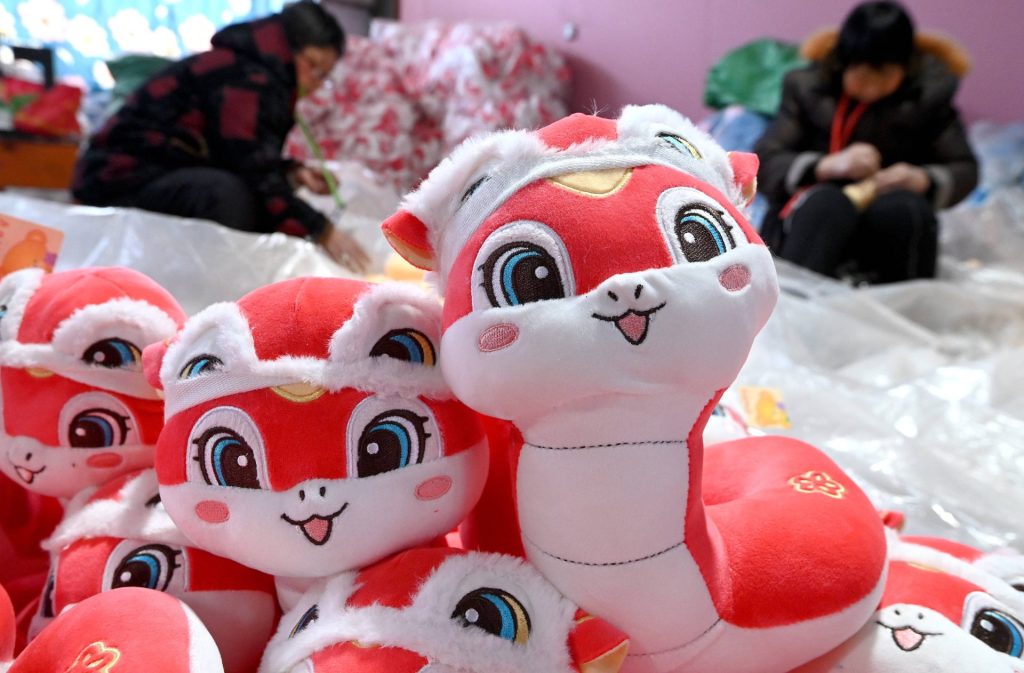Almost a decade ago, China launched its “Made in China 2025” plan, a comprehensive industrial modernization strategy that seemed very ambitious. Beijing has set development goals for ten key industries – from shipbuilding to semiconductor research – and proved that targeted industrial policy can lead to success. A prominent example of this is the Chinese automotive industry.
As we know, however, things are not all rosy for the Chinese economy, look at the rather poor economic situation. Treating technological innovation in export industries as the primary driver of growth even comes at the expense of prosperity, writes Leonardo Pape in his analysis.
As one of its last official acts, the Biden administration plans to ban Chinese and Russian components from connected vehicles – a measure that could shake up the automotive industries around the world. Christian Domke-Seidel analyzes the various implications and describes a Europe caught between the fronts, which must decide whether to follow the American path or continue to focus on the important Chinese market.
Have a pleasant read!


China’s President Xi Jinping once again used his New Year’s address to highlight his own industrial policy successes, such as the record sales of electric cars. However, one milestone was absent from both the New Year’s speech and other recent announcements: Made in China 2025.
Almost ten years ago, China’s State Council presented its comprehensive industrial modernization strategy. It set ambitious development targets for ten key industries, ranging from shipbuilding to semiconductor research. In the strategy, 2025 is only the first interim target on the way to a “world-leading technological and industrial system” by 2049, the much-vaunted 100th year since the founding of the People’s Republic. Around 2019, at the height of the trade war between the USA and China during Donald Trump’s first term in office, the government suddenly dropped the slogan Made in China 2025. To this day, it has not given a reason for this, but has also not distanced itself from the program.
Many observers see the fact that Made in China 2025 has disappeared from the official discourse as a sign of caution, as the first Trump administration put up a lot of resistance to it anyway. However, the Chinese leadership has retained the central logic of the strategy: Massive funding initiatives to catch up with global leaders in practically all key technology areas.
Max Zenglein from the China think tank Merics, who has extensively studied the implementation of Made in China 2025, sees this fundamental cross-sectoral modernization of Chinese industry in particular as “a complete success.” He says the strategy has set the general direction for China to develop from the world’s workbench into a manufacturing superpower.
Between 2016 and the end of 2023, the industrial automation rate, measured by the number of robots per 10,000 factory workers, increased sevenfold from 68 to 470. According to the International Federation of Robotics, with the third-highest automation rate in the world, China also overtook Germany for the first time (429 robots per 10,000 workers) – a few years ago, a declared role model of Chinese industrial policy with the concept of Industry 4.0. China also tried to replace imports with its own production wherever possible. Between 2016 and 2021, imports of industrial products still accounted for around ten percent of gross domestic product, but the ratio recently fell to 8.5 percent according to the analysis company Gavekal Dragonomics. According to Zenglein, the focus on economic self-sufficiency was not a reaction to external decoupling efforts; China was “already derisking when nobody here had it on their radar.”
As rosy as all this may sound from the Chinese government’s perspective, the generally poor economic situation also shows the dark side of top-down-driven industrial modernization. Many experts believe that betting on technological innovation in export industries as the primary growth driver comes at the expense of the prosperity of large sections of the Chinese population. The fact that the government in Beijing prefers to boost manufacturing industries rather than the purchasing power of consumers was particularly evident during the COVID-19 pandemic. Even in economically difficult times, it chose not to make transfer payments or fundamental improvements to the social security systems.
Made in China 2025 focuses on ten key industries. These were recently analyzed in detail by a fierce critic of the Communist Party: Marco Rubio, US Senator and future Secretary of State under Donald Trump, on whose behalf the detailed report The World China Made: ‘Made in China 2025’ Nine Years Later was published last September.
In the biomedicine, agricultural machinery and aerospace technology fields, China’s achievements are mixed: Chinese (and Indian) companies are leading in the production of generic drugs and research in the field of genomics is also well advanced. However, the country still depends on talent, technology and capital from foreign biotechnology and pharmaceutical companies. The largest Chinese aircraft manufacturer COMAC has established itself on the domestic market, but cannot (yet) compete with Boeing and Airbus on the international market. China has even failed completely in the development of internationally competitive agricultural machinery.
In contrast, China is a global leader in the future technologies of electromobility, renewable energy generation and shipbuilding. By 2024, China has tripled its target of selling three million electric vehicles a year. Over 80 percent of solar modules worldwide are manufactured in China. In recent years, the People’s Republic has surpassed South Korea and Japan to become the leading shipbuilding nation by far.
Marco Rubio believes that China remains dependent on foreign technologies in information and communication technologies, including semiconductor technology, such as lithography equipment from the Dutch company ASML. However, he notes that even though the market for high-performance chips remains dominated by the Taiwanese global market leader TSMC, China, and in particular the state-owned SMIC group, has successfully resisted the restrictions imposed by US export controls.
China has caught up in mechanical engineering and robot technology but has yet to produce its world-leading manufacturer of industrial robots. Instead, “China has bought a champion” – referring to Kuka, the German company and leading robot manufacturer, which has been majority-owned by the Chinese Midea Group since 2016.
Merics expert Zenglein considers it unlikely that China will fundamentally change its industrial policy approach in the face of external or internal pressure, even if this is at the expense of its own population, particularly the middle class. “Perhaps the volatility caused by Trump and the geopolitical tensions will even benefit the Chinese leadership because they can say: We have to stick together now, there is an external enemy.” Leonardo Pape

It could be the Biden administration’s last big trade policy measure: The planned US law on connected vehicles, NPRM (Notice of Proposed Rulemaking). At its core, it aims to ban Chinese and Russian components in connected cars for security reasons. Both hardware and software are affected. Its consequences are as unforeseeable as the details of the corresponding regulation remain unclear. After all, the automotive industry is more global than ever, and China plays a leading role in developing and constructing connected and smart vehicles.
Sensors that measure the distance to other vehicles, software code to make parking easier, cameras and microphones, Bluetooth technology and cloud solutions: Modern vehicles are high-tech and therefore a security risk from the US government’s point of view. They fear hacker attacks and espionage attempts by Chinese companies. Chinese components that could potentially be used for this are to be banned under the new regulation. The software ban could come into effect as early as 2027, while a transitional period until 2030 is planned for hardware components.
Specifically, the ban concerns key components such as sensors (e.g., cameras, LiDAR, radar), computing units (e.g., powerful computers), and actuators (e.g., steering and brake control systems and, of course, the software behind them). “The USA is taking a relatively aggressive approach here. It’s not about the level of certain tariffs, but about the fact that products from China are generally banned. What bothers the industry is that this is not about risk minimization, but about decoupling,” Gregor Sebastian accuses the Biden administration. He is a senior analyst in the China Corporate Advisory Team at the Rhodium Group.
And although American manufacturers – apart from Tesla – do not play a significant role in the Chinese market, the new regulation could backfire. The consequences are still unforeseeable. “From the US perspective, the big risk is that the cost of vehicles in or from the US will eventually be far higher than in the rest of the world. Manufacturers who have focused on the US market will then have to compete in third markets with cheaper and perhaps more innovative products,” says Sebastian. In other words, American products are less competitive in the global market, while Chinese products are even more so.
After all, the goal of pushing back Chinese participation in car manufacturers or limiting its influence on research and development is naive. It is much more likely that two parallel supply chains will emerge. One for vehicles to be sold in the USA and one for all other markets. Volkswagen, for example, already maintains strategic partnerships in the USA (Rivian) and China (Xpeng), which are at least comparable in terms of their technical objectives.
If implemented poorly or under pressure, this two-pronged approach could disadvantage customers, who could face production delays and higher costs, as Marcus Bollig, Managing Director of the German Association of the Automotive Industry, explained in a press release. After all, China is the innovation driver in this area. “Establishing parallel production capacities could slow down technological development,” Bollig adds. “Any move away from international, free trade brings disadvantages in terms of efficiency, development and also costs. That is why it is so important to maintain common standards.”
“The intention of the USA is certainly to achieve a deterrent effect with this law to reduce the Chinese influence on foreign companies. But it could become a huge problem for many vehicle manufacturers,” fears Gregor Sebastian. Many manufacturers have already started testing or offering Level 3 autonomous driving in the US. A lot of the underlying technology comes from China.
The US government’s evaluation criteria are still entirely unclear. Especially as a lot could change once Donald Trump takes office in January 2025. For example, how will the administration deal with a system in which only certain applications – such as parking assistants – were developed in China? What about Chinese investments? “Almost 20 percent of Mercedes-Benz belongs to Chinese owners. That certainly sets alarm bells ringing,” Sebastian sums up.
That is because the ban applies not only to products manufactured in China, but also to products “designed, developed, manufactured, or supplied by entities with a sufficient nexus to the PRC or Russia.” This puts a big question mark over the complex network of shareholdings, investments, technology partnerships and joint ventures between European vehicle manufacturers in China and Chinese companies in the rest of the world. Many manufacturers and suppliers have massively expanded their activities in the People’s Republic as part of their de-risking strategy and invested billions – also to take advantage of Chinese research and development. China is considered a driver of innovation in this area. However, whether the results can still be used for the American market is uncertain.
Europe is caught between the two economic powers in the trade disputes and does not want to damage its relations with either of them. “Europe will probably not copy the rules from the USA 1:1 and ban Chinese manufacturers and products from the market. The EU wants to avoid a two-sided trade conflict and continue to attract Chinese investment,” Sebastian clarifies. However, he also points out: “However, the EU also wants to contain cybersecurity risks and this could also make market access more difficult for Chinese manufacturers.” Europe’s approach will also depend heavily on what steps the Trump administration announces.
Because as important as China may be for German companies, abandoning the American market is also out of the question, as Bollig makes clear. “The German automotive industry employs 138,000 people in the United States of America. Around one in eleven vehicles produced in the USA in the light vehicle category bears the logo of a German brand. Production by German vehicle manufacturers grew by ten percent in 2023.”
Accordingly, the VDA and the manufacturers have also used their right of objection. As Bollig puts it, the planned transitional periods are “simply not feasible,” arguing that this could lead to a loss of driving comfort and individual safety features would not be available. It is also unclear whether cars that are already in production are affected.
With all the planning and uncertainties, there is still the question of how credible the security argument is. “Today, there are already standards and proven procedures for cybersecurity in type approval,” Bollig clarifies. German manufacturers scrutinize all components. After all, UNECE Regulation 155 of the United Nations Economic Commission for Europe already exists – it stipulates a cybersecurity management system. “Only once this has been proven to work does a vehicle receive type approval for the road,” says Bollig. Collaboration: Julia Fiedler
A severe earthquake has shaken the autonomous province of Tibet. According to Chinese state media, at least 126 people lost their lives and 188 were injured. The earthquake hit the remote county of Tingri, which lies on the north side of Mount Everest and around 400 kilometers west of the Tibetan capital Lhasa. The nearest major city is the holy city of Shigatse, which is about 180 kilometers away and is traditionally the seat of the Panchen Lama, the second most important Tibetan religious dignitary after the Dalai Lama.
CCTV cameras in Shigatse showed customers running out of a supermarket and goods falling to the ground. The quake could also be felt in neighboring Nepal and parts of India. According to the Chinese earthquake center, it had a magnitude of 6.8, while the US earthquake observatory USGS gave the magnitude as 7.1. The quake is one of the deadliest that China has experienced in recent years.
Footage from Chinese state television CCTV showed rescue workers making their way through broken houses to distribute blankets to the victims. According to the Chinese Meteorological Administration, temperatures in Tingri are at minus eight degrees and will drop to minus 18 degrees at night. aiko
Chinese human rights lawyer Yu Wensheng remains in prison despite international protests. On Monday, the Intermediate People’s Court in Suzhou upheld its decision from October last year, according to which the 57-year-old will remain in prison for three years until April 2026 for “inciting subversion of state power.” The European Union expressed its deep regret at the upholding of the sentence. The EU reiterated its call for his immediate and unconditional release.
Together with his wife Xu Yan, Yu was arrested on April 13, 2023 on his way to a meeting with the EU delegation in Beijing. Xu is also in custody. The Chinese judiciary also confirmed her sentence on Monday. However, she will have served her sentence in full on January 13. Germany, France and the USA strongly condemned the guilty verdict at the time.
Yu Wensheng is one of the most prominent Chinese lawyers who has repeatedly acted as a lawyer for human rights activists in China. In 2019, he was already imprisoned for four years after calling for political reforms and the introduction of elections in an open letter. Yu was previously arrested in 2014 after supporting the umbrella protests in Hong Kong. In recognition of his work, he was awarded the Franco-German Prize for Human Rights in 2018. grz
The Chinese government confirmed that Xi Jinping and Donald Trump had spoken after Trump’s election as the new US president. The confirmation came after Trump told conservative radio journalist Hugh Hewitt on Monday that he and Xi were in contact through their representatives and that he expected “we’ll probably get along very well.”
When asked by a journalist, Chinese Foreign Ministry spokesperson Guo Jiakun explained that the Chinese government “attaches great importance” to Trump’s remark. During the interview, Donald Trump had said he believed he and Xi will get along but it had to be a “two-way street”, repeating that China has been “ripping off” the US economically. Guo noted that, in China’s view, both countries benefit from economic and trade relations. aiko


Sinolytics is a research-based business consultancy entirely focused on China. It advises European companies on their strategic orientation and specific business activities in the People’s Republic.
Ning Wang has recently been appointed Head of Digital Solutions at Airbus China Customer Services. The graduate aerospace engineer, who trained in Stuttgart, among other places, has been working for Airbus for more than eleven years, most recently as Project Executive at the Airbus China Innovation Center. He moved from Shenzhen to Beijing for his new post.
Jochen Sengpiehl, previously Head of Marketing at Volkswagen in China, has left the company. The reason for his departure is his expulsion from China at the end of October last year due to a positive drug test. Information regarding his successor is not yet known.
Is something changing in your organization? Let us know at heads@table.media!

It takes a little imagination to realize that these cuddly toys are supposed to be snakes. But it’s the symbol that counts. The Year of the Wooden Snake is just a few weeks away in China. Naturally, a flood of snake merchandise will be produced to mark the occasion, as here in Handan, Hebei.
Almost a decade ago, China launched its “Made in China 2025” plan, a comprehensive industrial modernization strategy that seemed very ambitious. Beijing has set development goals for ten key industries – from shipbuilding to semiconductor research – and proved that targeted industrial policy can lead to success. A prominent example of this is the Chinese automotive industry.
As we know, however, things are not all rosy for the Chinese economy, look at the rather poor economic situation. Treating technological innovation in export industries as the primary driver of growth even comes at the expense of prosperity, writes Leonardo Pape in his analysis.
As one of its last official acts, the Biden administration plans to ban Chinese and Russian components from connected vehicles – a measure that could shake up the automotive industries around the world. Christian Domke-Seidel analyzes the various implications and describes a Europe caught between the fronts, which must decide whether to follow the American path or continue to focus on the important Chinese market.
Have a pleasant read!


China’s President Xi Jinping once again used his New Year’s address to highlight his own industrial policy successes, such as the record sales of electric cars. However, one milestone was absent from both the New Year’s speech and other recent announcements: Made in China 2025.
Almost ten years ago, China’s State Council presented its comprehensive industrial modernization strategy. It set ambitious development targets for ten key industries, ranging from shipbuilding to semiconductor research. In the strategy, 2025 is only the first interim target on the way to a “world-leading technological and industrial system” by 2049, the much-vaunted 100th year since the founding of the People’s Republic. Around 2019, at the height of the trade war between the USA and China during Donald Trump’s first term in office, the government suddenly dropped the slogan Made in China 2025. To this day, it has not given a reason for this, but has also not distanced itself from the program.
Many observers see the fact that Made in China 2025 has disappeared from the official discourse as a sign of caution, as the first Trump administration put up a lot of resistance to it anyway. However, the Chinese leadership has retained the central logic of the strategy: Massive funding initiatives to catch up with global leaders in practically all key technology areas.
Max Zenglein from the China think tank Merics, who has extensively studied the implementation of Made in China 2025, sees this fundamental cross-sectoral modernization of Chinese industry in particular as “a complete success.” He says the strategy has set the general direction for China to develop from the world’s workbench into a manufacturing superpower.
Between 2016 and the end of 2023, the industrial automation rate, measured by the number of robots per 10,000 factory workers, increased sevenfold from 68 to 470. According to the International Federation of Robotics, with the third-highest automation rate in the world, China also overtook Germany for the first time (429 robots per 10,000 workers) – a few years ago, a declared role model of Chinese industrial policy with the concept of Industry 4.0. China also tried to replace imports with its own production wherever possible. Between 2016 and 2021, imports of industrial products still accounted for around ten percent of gross domestic product, but the ratio recently fell to 8.5 percent according to the analysis company Gavekal Dragonomics. According to Zenglein, the focus on economic self-sufficiency was not a reaction to external decoupling efforts; China was “already derisking when nobody here had it on their radar.”
As rosy as all this may sound from the Chinese government’s perspective, the generally poor economic situation also shows the dark side of top-down-driven industrial modernization. Many experts believe that betting on technological innovation in export industries as the primary growth driver comes at the expense of the prosperity of large sections of the Chinese population. The fact that the government in Beijing prefers to boost manufacturing industries rather than the purchasing power of consumers was particularly evident during the COVID-19 pandemic. Even in economically difficult times, it chose not to make transfer payments or fundamental improvements to the social security systems.
Made in China 2025 focuses on ten key industries. These were recently analyzed in detail by a fierce critic of the Communist Party: Marco Rubio, US Senator and future Secretary of State under Donald Trump, on whose behalf the detailed report The World China Made: ‘Made in China 2025’ Nine Years Later was published last September.
In the biomedicine, agricultural machinery and aerospace technology fields, China’s achievements are mixed: Chinese (and Indian) companies are leading in the production of generic drugs and research in the field of genomics is also well advanced. However, the country still depends on talent, technology and capital from foreign biotechnology and pharmaceutical companies. The largest Chinese aircraft manufacturer COMAC has established itself on the domestic market, but cannot (yet) compete with Boeing and Airbus on the international market. China has even failed completely in the development of internationally competitive agricultural machinery.
In contrast, China is a global leader in the future technologies of electromobility, renewable energy generation and shipbuilding. By 2024, China has tripled its target of selling three million electric vehicles a year. Over 80 percent of solar modules worldwide are manufactured in China. In recent years, the People’s Republic has surpassed South Korea and Japan to become the leading shipbuilding nation by far.
Marco Rubio believes that China remains dependent on foreign technologies in information and communication technologies, including semiconductor technology, such as lithography equipment from the Dutch company ASML. However, he notes that even though the market for high-performance chips remains dominated by the Taiwanese global market leader TSMC, China, and in particular the state-owned SMIC group, has successfully resisted the restrictions imposed by US export controls.
China has caught up in mechanical engineering and robot technology but has yet to produce its world-leading manufacturer of industrial robots. Instead, “China has bought a champion” – referring to Kuka, the German company and leading robot manufacturer, which has been majority-owned by the Chinese Midea Group since 2016.
Merics expert Zenglein considers it unlikely that China will fundamentally change its industrial policy approach in the face of external or internal pressure, even if this is at the expense of its own population, particularly the middle class. “Perhaps the volatility caused by Trump and the geopolitical tensions will even benefit the Chinese leadership because they can say: We have to stick together now, there is an external enemy.” Leonardo Pape

It could be the Biden administration’s last big trade policy measure: The planned US law on connected vehicles, NPRM (Notice of Proposed Rulemaking). At its core, it aims to ban Chinese and Russian components in connected cars for security reasons. Both hardware and software are affected. Its consequences are as unforeseeable as the details of the corresponding regulation remain unclear. After all, the automotive industry is more global than ever, and China plays a leading role in developing and constructing connected and smart vehicles.
Sensors that measure the distance to other vehicles, software code to make parking easier, cameras and microphones, Bluetooth technology and cloud solutions: Modern vehicles are high-tech and therefore a security risk from the US government’s point of view. They fear hacker attacks and espionage attempts by Chinese companies. Chinese components that could potentially be used for this are to be banned under the new regulation. The software ban could come into effect as early as 2027, while a transitional period until 2030 is planned for hardware components.
Specifically, the ban concerns key components such as sensors (e.g., cameras, LiDAR, radar), computing units (e.g., powerful computers), and actuators (e.g., steering and brake control systems and, of course, the software behind them). “The USA is taking a relatively aggressive approach here. It’s not about the level of certain tariffs, but about the fact that products from China are generally banned. What bothers the industry is that this is not about risk minimization, but about decoupling,” Gregor Sebastian accuses the Biden administration. He is a senior analyst in the China Corporate Advisory Team at the Rhodium Group.
And although American manufacturers – apart from Tesla – do not play a significant role in the Chinese market, the new regulation could backfire. The consequences are still unforeseeable. “From the US perspective, the big risk is that the cost of vehicles in or from the US will eventually be far higher than in the rest of the world. Manufacturers who have focused on the US market will then have to compete in third markets with cheaper and perhaps more innovative products,” says Sebastian. In other words, American products are less competitive in the global market, while Chinese products are even more so.
After all, the goal of pushing back Chinese participation in car manufacturers or limiting its influence on research and development is naive. It is much more likely that two parallel supply chains will emerge. One for vehicles to be sold in the USA and one for all other markets. Volkswagen, for example, already maintains strategic partnerships in the USA (Rivian) and China (Xpeng), which are at least comparable in terms of their technical objectives.
If implemented poorly or under pressure, this two-pronged approach could disadvantage customers, who could face production delays and higher costs, as Marcus Bollig, Managing Director of the German Association of the Automotive Industry, explained in a press release. After all, China is the innovation driver in this area. “Establishing parallel production capacities could slow down technological development,” Bollig adds. “Any move away from international, free trade brings disadvantages in terms of efficiency, development and also costs. That is why it is so important to maintain common standards.”
“The intention of the USA is certainly to achieve a deterrent effect with this law to reduce the Chinese influence on foreign companies. But it could become a huge problem for many vehicle manufacturers,” fears Gregor Sebastian. Many manufacturers have already started testing or offering Level 3 autonomous driving in the US. A lot of the underlying technology comes from China.
The US government’s evaluation criteria are still entirely unclear. Especially as a lot could change once Donald Trump takes office in January 2025. For example, how will the administration deal with a system in which only certain applications – such as parking assistants – were developed in China? What about Chinese investments? “Almost 20 percent of Mercedes-Benz belongs to Chinese owners. That certainly sets alarm bells ringing,” Sebastian sums up.
That is because the ban applies not only to products manufactured in China, but also to products “designed, developed, manufactured, or supplied by entities with a sufficient nexus to the PRC or Russia.” This puts a big question mark over the complex network of shareholdings, investments, technology partnerships and joint ventures between European vehicle manufacturers in China and Chinese companies in the rest of the world. Many manufacturers and suppliers have massively expanded their activities in the People’s Republic as part of their de-risking strategy and invested billions – also to take advantage of Chinese research and development. China is considered a driver of innovation in this area. However, whether the results can still be used for the American market is uncertain.
Europe is caught between the two economic powers in the trade disputes and does not want to damage its relations with either of them. “Europe will probably not copy the rules from the USA 1:1 and ban Chinese manufacturers and products from the market. The EU wants to avoid a two-sided trade conflict and continue to attract Chinese investment,” Sebastian clarifies. However, he also points out: “However, the EU also wants to contain cybersecurity risks and this could also make market access more difficult for Chinese manufacturers.” Europe’s approach will also depend heavily on what steps the Trump administration announces.
Because as important as China may be for German companies, abandoning the American market is also out of the question, as Bollig makes clear. “The German automotive industry employs 138,000 people in the United States of America. Around one in eleven vehicles produced in the USA in the light vehicle category bears the logo of a German brand. Production by German vehicle manufacturers grew by ten percent in 2023.”
Accordingly, the VDA and the manufacturers have also used their right of objection. As Bollig puts it, the planned transitional periods are “simply not feasible,” arguing that this could lead to a loss of driving comfort and individual safety features would not be available. It is also unclear whether cars that are already in production are affected.
With all the planning and uncertainties, there is still the question of how credible the security argument is. “Today, there are already standards and proven procedures for cybersecurity in type approval,” Bollig clarifies. German manufacturers scrutinize all components. After all, UNECE Regulation 155 of the United Nations Economic Commission for Europe already exists – it stipulates a cybersecurity management system. “Only once this has been proven to work does a vehicle receive type approval for the road,” says Bollig. Collaboration: Julia Fiedler
A severe earthquake has shaken the autonomous province of Tibet. According to Chinese state media, at least 126 people lost their lives and 188 were injured. The earthquake hit the remote county of Tingri, which lies on the north side of Mount Everest and around 400 kilometers west of the Tibetan capital Lhasa. The nearest major city is the holy city of Shigatse, which is about 180 kilometers away and is traditionally the seat of the Panchen Lama, the second most important Tibetan religious dignitary after the Dalai Lama.
CCTV cameras in Shigatse showed customers running out of a supermarket and goods falling to the ground. The quake could also be felt in neighboring Nepal and parts of India. According to the Chinese earthquake center, it had a magnitude of 6.8, while the US earthquake observatory USGS gave the magnitude as 7.1. The quake is one of the deadliest that China has experienced in recent years.
Footage from Chinese state television CCTV showed rescue workers making their way through broken houses to distribute blankets to the victims. According to the Chinese Meteorological Administration, temperatures in Tingri are at minus eight degrees and will drop to minus 18 degrees at night. aiko
Chinese human rights lawyer Yu Wensheng remains in prison despite international protests. On Monday, the Intermediate People’s Court in Suzhou upheld its decision from October last year, according to which the 57-year-old will remain in prison for three years until April 2026 for “inciting subversion of state power.” The European Union expressed its deep regret at the upholding of the sentence. The EU reiterated its call for his immediate and unconditional release.
Together with his wife Xu Yan, Yu was arrested on April 13, 2023 on his way to a meeting with the EU delegation in Beijing. Xu is also in custody. The Chinese judiciary also confirmed her sentence on Monday. However, she will have served her sentence in full on January 13. Germany, France and the USA strongly condemned the guilty verdict at the time.
Yu Wensheng is one of the most prominent Chinese lawyers who has repeatedly acted as a lawyer for human rights activists in China. In 2019, he was already imprisoned for four years after calling for political reforms and the introduction of elections in an open letter. Yu was previously arrested in 2014 after supporting the umbrella protests in Hong Kong. In recognition of his work, he was awarded the Franco-German Prize for Human Rights in 2018. grz
The Chinese government confirmed that Xi Jinping and Donald Trump had spoken after Trump’s election as the new US president. The confirmation came after Trump told conservative radio journalist Hugh Hewitt on Monday that he and Xi were in contact through their representatives and that he expected “we’ll probably get along very well.”
When asked by a journalist, Chinese Foreign Ministry spokesperson Guo Jiakun explained that the Chinese government “attaches great importance” to Trump’s remark. During the interview, Donald Trump had said he believed he and Xi will get along but it had to be a “two-way street”, repeating that China has been “ripping off” the US economically. Guo noted that, in China’s view, both countries benefit from economic and trade relations. aiko


Sinolytics is a research-based business consultancy entirely focused on China. It advises European companies on their strategic orientation and specific business activities in the People’s Republic.
Ning Wang has recently been appointed Head of Digital Solutions at Airbus China Customer Services. The graduate aerospace engineer, who trained in Stuttgart, among other places, has been working for Airbus for more than eleven years, most recently as Project Executive at the Airbus China Innovation Center. He moved from Shenzhen to Beijing for his new post.
Jochen Sengpiehl, previously Head of Marketing at Volkswagen in China, has left the company. The reason for his departure is his expulsion from China at the end of October last year due to a positive drug test. Information regarding his successor is not yet known.
Is something changing in your organization? Let us know at heads@table.media!

It takes a little imagination to realize that these cuddly toys are supposed to be snakes. But it’s the symbol that counts. The Year of the Wooden Snake is just a few weeks away in China. Naturally, a flood of snake merchandise will be produced to mark the occasion, as here in Handan, Hebei.
